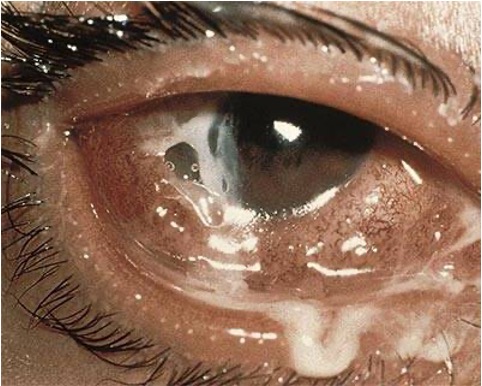27-year-old man with a red, painful eye
Cataract/Anterior Segment, Comprehensive Ophthalmology, Cornea/External Disease
What is your diagnosis?

The diagnosis is...
![]()

The image is consistent with a diagnosis of bacterial conjunctivitis:
- Conjunctivitis is the inflammation of the conjunctiva due to bacterial or viral infection, an allergy, or exposure to an irritant.
- Bacterial and viral conjunctivitis are contagious and spread easily.
- Allergic conjunctivitis is not contagious.
What is the role of the primary care or emergency medicine physician?
![]()
- Instruct the patient to stay home from school or work until symptoms are resolved to prevent the spread of illness.
- Recommend regular handwashing (especially after touching the eyes) and avoiding contact with others (including the sharing of towels).
- Refer the patient to an ophthalmologist if the symptoms are severe.
What is the role of the ophthalmologist?
![]()
- Use a slit-lamp biomicroscope to diagnose conjunctivitis.

- Rule out other causes of red eye, such as uveitis or corneal issues.
- Determine if the patient's condition is vision-threatening.
- Differentiate between viral and bacterial conjunctivitis:
- Viral conjunctivitis is associated with watery discharge, mild to moderate injection (redness of the conjunctival vessels), and often an upper respiratory infection.
- Bacterial conjunctivitis is associated with thick, purulent discharge and significant injection.
- If bacterial conjunctivitis is suspected, prescribe antibiotic eyedrops.
- If viral conjunctivitis is suspected, provide supportive treatment to help relieve symptoms.
What is the treatment?
![]()
Most cases of viral conjunctivitis are self-limited. The use of cool artificial tears and compresses can help with eye discomfort.
Antibiotic eyedrops can shorten the disease course in all patients with bacterial conjunctivitis. Consider culturing the discharge for chlamydia or gonorrhea. Patients suspected of having chlamydia or gonorrhea should be treated with systemic antibiotics and monitored closely for corneal perforation. In children, chlamydial or gonorrheal conjunctivitis must be reported as child abuse.
Treatment of allergic conjunctivitis ranges from avoiding contact with the allergen to using antiallergy eyedrops or systemic medications.
Learn more: Ophthalmology resources for medical students
![]()